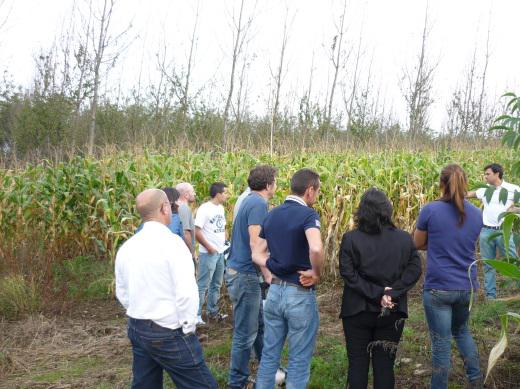
Sistema silvoarabile in Spagna
Descrizione del sistema
In Galizia, nel nord est della Spagna, l’azienda “Bosques Naturales“ sta conducendo esperimenti riguardanti systemy agroforestali. In particolare lo studio riguarda la combinazione di alberi di noce (Juglans spp) con il mais (Zea mays).
Meeting iniziale con gli stakeholders
Al primo incontro con gli stakeholders tenutosi il 21 Ottobre 2014, hanno aderito 14 partecipanti. Gli aspetti più positivi emersi dall’analisi dei sistemi agroforestali, includono nuove opportunità per il mercato, idee originali ed interessanti, la fattibilità dei progetti, la diversificazione dei prodotti ed in generale i benefici ambientali offerti. Gli aspetti negativi invece riguardano la maggior complessità del sistema che richiede maggiori costi di manodopera e gestione, ed è più soggetto a perdite dovute alla fauna selvatica. L’integrazione di alberi, mais e piante medicinali, assieme alla protezione degli alberi da parte di animali sono state identificate come possibili tematiche di ricerca da sviluppare.
Per maggiori informazioni sull’attività del gruppo prego di contattare Prof. María Rosa Mosquera Losada (mrosa.mosquera.losada@usc.es)
Download the initial stakeholder report
Download the initial research and development protocol
A research protocol developed by the stakeholder group focused on the growth of cereals within high value walnut plantations (which was originally reported in work-package 2) near Toledo in central Spain was produced in March 2015. A research protocol on cultivation of medicinal plants and maize between wild cherry in Galicia was also produced in March 2015.
Download the system description
A research update on cereal production beneath walnut for quality timber production in central Spain was produced in October 2015. A research update on growing medicinal plants and maize between wild cherry in Galicia was produced in January 2016.
Lessons learnt
María Guadalupe Arenas-Corraliza, María Lourdes López-Díaz and Gerardo Moreno have completed a lessons learnt report describing the details of a comprehensive set of measurements looking at the interactions between growing walnut trees and wheat and barley crops in Mediterranean Spain.
A shading experiment demonstrated that barley and wheat yields in Mediterranean Spain could be increased with partial or 50% shade, compared to yields in full sunlight. Under some particularly dry and hot years, when the yield of the monoculture barley crop was particularly low, growing the barley within the trees increased barley yields. The effect on barley yields was more positive than that on wheat yields, because the barley crop can complete much of its development before significant leaf growth on the walnut trees. By contrast in cooler and wetter seasons, the highest barley and wheat yields were obtained from the monoculture crop. Measurement of tree growth, also indicated that the cereals reduced tree growth; it is possible that this could be prevented through the use of irrigation. In summary, the results demonstrate that barley yields in particularly dry and hot years can be maintained through the use of tree cover.
Lessons learnt
Rosa Mosquera-Losada and colleagues at the University of Santiago de Compostela have produced two reports. The first describes the responses of maize intercropped between wild cherry trees (Prunus avium L). In an experiment where the trees had been planted in 2008 at interrow spacings of 1.25, 2.5 and 5 m, the total dry biomass produced by intercropped maize (per cropped area) of 4.4 to 14.0 t/ha, was lower than the approximately 25 t/ha of biomass produced in plots without trees due to the spaced occupied by the tree rows. Maize has a “C4” photosynthetic pathway and can respond positively to high light levels. There is a recommendation to test the shade responses of maize varieties to increase production under shade.
The second report focuses on the response of two medicinal crops (Melissa officinalis L. and Mentha x piperita L.) intercropped between wild cherry trees. The yields, although low at 0.3-0.7 t/ha, are similar to those obtained in other studies in open sites. Hence they appear suitable agroforestry crops. The concentration of Rosmarinic acid in the leaves of Melissa officinalis was higher when the crop was grown under a high density, rather than a lower density, of trees. This may be explained because the concentration of Rosamarinic acid is higher before flowering and tree shade delays flowering.